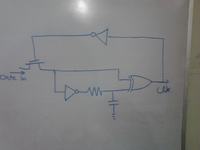iVenky
Advanced Member level 2
- Joined
- Jul 11, 2011
- Messages
- 584
- Helped
- 37
- Reputation
- 76
- Reaction score
- 35
- Trophy points
- 1,318
- Location
- College Station, Texas
- Activity points
- 6,124
I am doing the IC design for data and clock recovery of Ask waveform of a Manchester coded data. I have no problem with the demodulation of Ask waveform to Manchester coded format. Now I want to recover the clock from the Manchester coded format and I am finding it really difficult. I have searched many IEEE papers. All those specify that I need a mono-flop (i.e. it will respond only for a certain period of time and if any trigger is there, a high/low voltage pulse will be the output.(during which it will not respond). ) I need the exact circuit to implement this operation. Note that there is no PLL involved.
How do you recover clock usually from a Manchester coded data as in passive RFID tags?
Thanks in advance.
How do you recover clock usually from a Manchester coded data as in passive RFID tags?
Thanks in advance.

